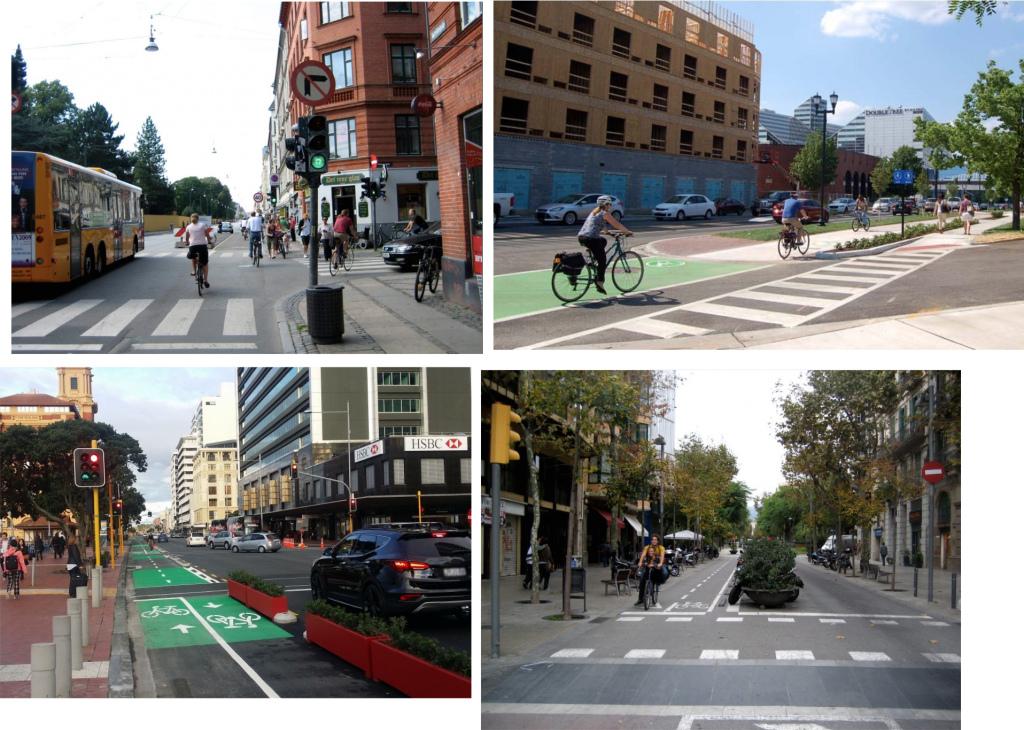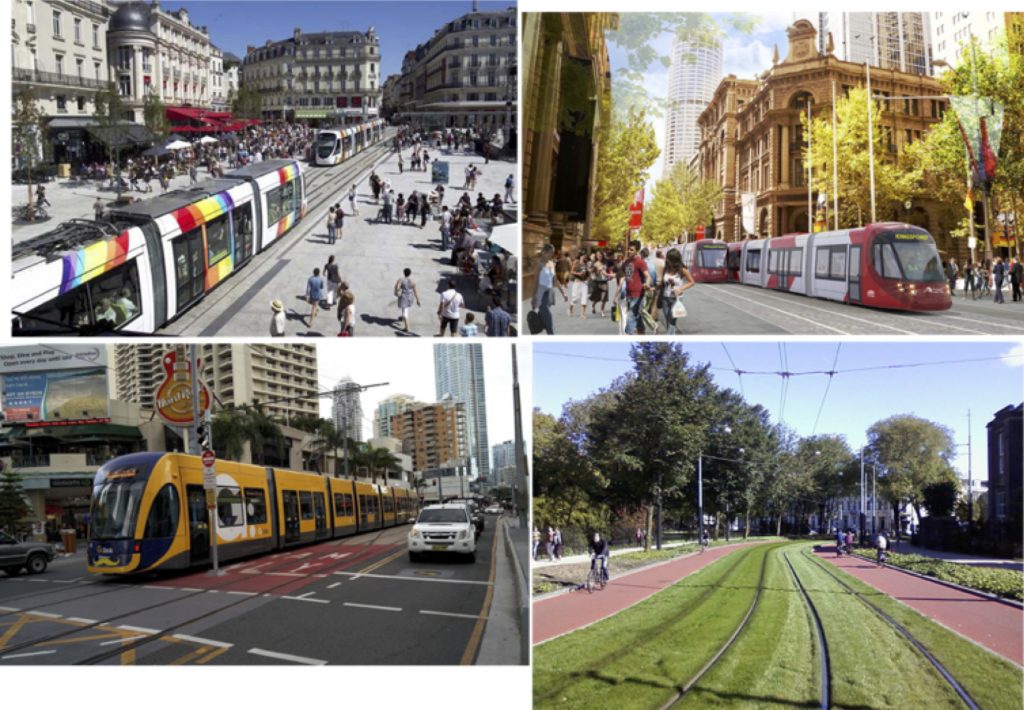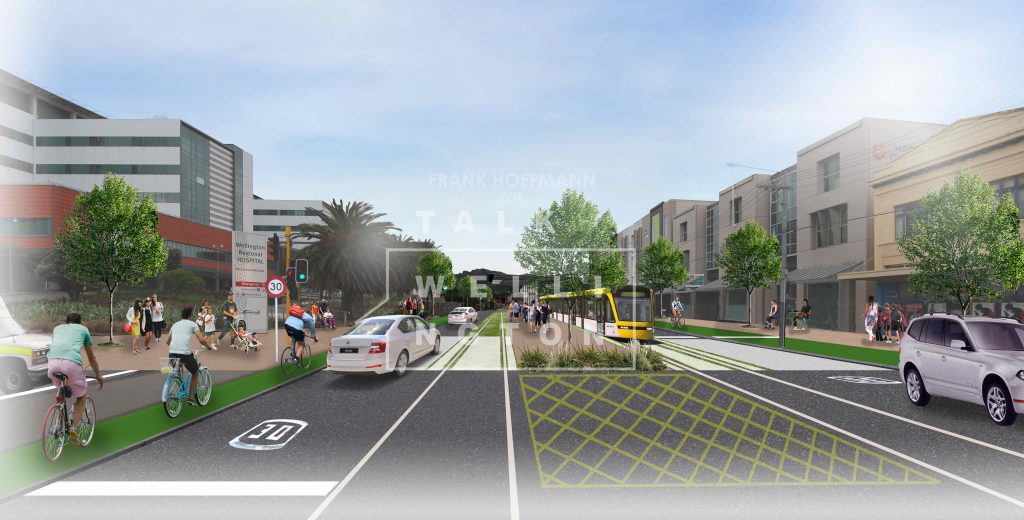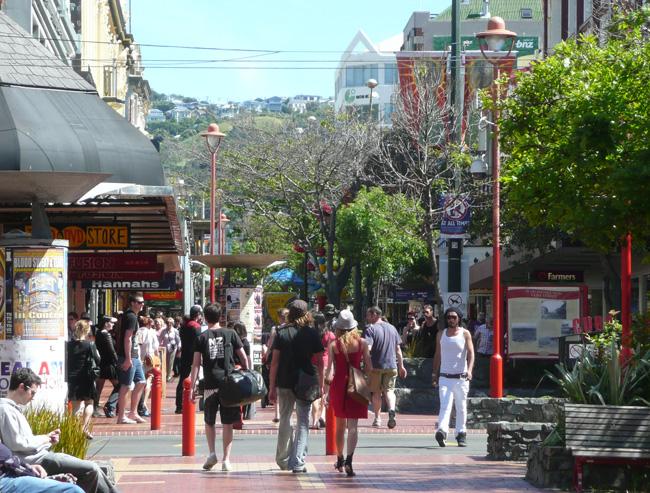Streets for people
Part five of a six-part series, compiled by Talk Wellington, that outlines a sensible vision for transport. This is a space that needs filling even as Let’s Get Wellington Moving prepares to spend $4 billion on transport in the capital.
We’ve covered the logic behind the better vision for transport in Wellington. Now in Parts Five and Six of our series, we see first how our city streets would look and feel if they were working properly for us. Note this is the fully illustrated version of the Stuff.co.nz / Dominion Post article .
Every space has its vibe, and instead of just going, “We put up a 30km sign, job done,” we need the space to say loud and clear to everyone: we go slowly here, chill out a bit, look out for other humans. Streets can say that to you, you feel it. – Kara Dentice, 28, Wainuiomata
What’s the point of a city? It’s the magic that happens when many people are doing different, vibrant, interesting things in close proximity. Efficient transport is vital, but it’s a means to an end: we move so we can be somewhere. In great cities the moving supports the being, rather than spoiling it.
As Wellingtonians, we love the way our city offers so many things to do, so close together. And we have some great public spaces – Civic Square, the Botanic Gardens, the waterfront. But ordinary streets can be great public spaces, too. They can be places for people to linger, socialise, enjoy nature, play games, or just take in the ever-changing panorama of human life that cities present.
That’s not generally the case at present. On most city streets, once you’re outside a motor vehicle, you become a second-class citizen in the so-called walkable capital.
But what would Wellington streets be like if we prioritised people and life on our streets?
For starters, there would be fewer private cars in the city centre, something Wellingtonians called for strongly in Let’s Get Wellington Moving consultation. There’d also be a mass transit spine, and more public transport, walking and cycling routes.
And we’d copy a recipe that’s working in cities worldwide, adapted for our local conditions. In the best, most truly ‘pro-people’ cities, the streets have:
- a real, universal speed limit of 30km – for all vehicles;
- wider-than-NZ-usual footpaths;
- more greenery, including trees, shrubs and stormwater gardens;
- more things for people, like seats, shelters and water fountains; and
- less traffic noise and better air quality.
These cities make use of four basic elements: movement-focused streets, mass transit, shared streets, and people-only spaces. Let’s explore what that might look like in our city.
1. Movement-focused streets
In Talk Wellington’s vision for the capital, a select minority of thoroughfares are movement-focused streets, serving, as their name suggests, primarily to move people and goods around. They have wider footpaths and a 30km speed limit, but still carry more than 5000 motor vehicles a day. (Think of a more attractive version of the Terrace.) Some of these streets have four vehicle lanes, others two. These are the kinds of streets you choose when you want to travel briskly.
Below we can see some typical features of movement-focused streets from Copenhagen (top left), Washington (top right), Auckland (bottom left), Barcelona (bottom right):

1. Minimal on-street parking (it’s mostly mobility parking): priority is moving people and goods
2. Footpaths are broad, attractive spaces for walking, wheelchairing, sitting out
3. All vehicles (incuding bikes, public transport) observing 30km/h speed limit
4. Dedicated places for safe crossing, with smart traffic signals responding to conditions
5. ‘Little road’ / rori iti separated from footpath and traffic lane, for cycling, e-scooting and even fast running
6. Any public transport has dedicated lanes, priority at intersections. Buses connect to mass transit (see below)

2. Mass transit
Mass transit can be any of several options, including light rail, bus rapid transit, and “bus-trains”. But whatever the technological choice, mass transit is the unlocking force for pro-people cities, thanks to its ability to move large numbers of people within a crowded urban centre.
Mass transit is special because it can run on everything from completely separated spaces (such as overhead rail lines or underground tunnels) through to busy pedestrian-only plazas. There are several potential routes for a Wellington mass transit service, but they all involve a “forked spine” on movement-focused streets, running between the railway station, city centre, hospital and southern suburbs, eastern suburbs, and potentially the airport.
The below pictures illustrate some features of typical mass transit in Angers (top left), Sydney (top right), Gold Coast (bottom left), Amsterdam (bottom right)

1. Mass transit vehicles pass regularly and frequently, every 5 to 10 minutes, taking about 30 seconds to pass.
2. Bells (and smart traffic signals, see above) help impaired people to cross safely
3. Mass transit vehicles travel at 30km/h in lanes free from general traffic, with priority at intersections
4. Emergency vehicles can use mass transit lanes anytime
5. Mass transit street may also have general traffic, a rori iti (see above), or just pedestrians, scooters, bikes
6. Space between tracks can be planted: less stormwater runoff, better air quality
These are some visualisations of the movement street and mass transit elements applied in Wellington.

Riddiford St by Wellington Hospital, showing how mass transit and movement-focused street elements could apply. Visualisation: Frank Hoffman

3. Shared streets
In our vision, the great majority of Wellington’s streets are designed so that people, both moving and lingering, feel like they’re first-class citizens.
Here, everyone using the space mingles at a speed that’s pedestrian-friendly – cars, vans, people walking, people on scooters and bikes. At the intersections with movement-focused streets, the vehicles carrying the largest numbers of people – mass transit and buses – get priority.
The below pictures illustrate some typical features of shared streets from Madrid (top left), Bonn (top right), Durham (bottom left), Zurich (bottom right):

1. Wider, smoother footpaths, with regular places to rest, plenty of things to use and enjoy (trees, water fountains, stormwater gardens, cafe chairs and tables, scooter and bike parking) plus consistent passage for people walking and in wheelchairs
2. Minimal on-street car parking (mostly mobility parking)
3. Relatively little traffic – fewer than 2500 vehicles a day (think Brandon St, Ballance St).
4. Frequent crossing points with smart traffic signals responding to conditions
5. All traffic, including bikes, travels at under 30km/h
6. Clever street design makes traffic lanes feel narrower, naturally encouraging slower driving speeds
7. People cycling and e-scooting safely share space with motor vehicles, not pedestrians
8. Larger shared streets have drop-off zones for couriers and supply vehicles. Some smaller streets have “filters” – bollards ensuring everyone but large vehicles can pass through
9. Large-tonnage private vehicles are absent except for business deliveries at specific times
4. People-only spaces
On top of all this, there would be more places that, like Cuba Mall and Civic Square, are pedestrian-only and ideal for public gatherings, live performance, and events.

What about retailers?
These new kinds of streets are good for business – because they’re good for people. Much as Wellingtonians might hate to admit it of our rival, Auckland’s transformation of its inner-city streets is working well, as the images below show. It’s also proving that it’s a focus on people, not cars and carparks, that make town centres vibrant and generate business for retailers.

Figures: Auckland Council shared space evaluations (2012, 2015). Photos: Oh.Yes.Melbourne2. Infographic: Celia McAlpine
As Chris Wilkinson, of national retail strategy consultancy First Retail, says, “Worldwide, great retail environments combine shopping, dining and entertainment with good public spaces. Invariably this means creating havens where people aren’t competing with vehicles, can connect easily by public transport, and can easily walk and cycle.”
What will be the upshot of all these changes?
There’ll be less on-street parking. In some places it’ll be slower to drive through – though better overall, thanks to more people taking other methods of transport. And it’ll be much easier to move around by walking, scooting or cycling, and by public transport. In addition, streets will be nicer to be in, more commercially vibrant, and more conducive to all the different activities people want to do.
Whether you want to walk and talk and shop, or sit and talk, or simply pause and enjoy life in our city, you’ll find that intelligent transport and unashamedly people-centric streets will let Wellington blossom like never before.
In the second part of this Saturday’s edition and the final in our series, we’ll see how these street types should be combined into a Wellington street network that’ll let our city flourish, and give people real transport choices.
Haven’t read the other parts yet? Have a browse of part one, part two, part three, and part 4.
Banner image: Adelaide Road by Aaron Miller
Montage image credits: (In order Top left – top right – bottom left – bottom right)
- Mass transit montage:
- Angers, from GreaterAuckland
- Sydney, by Hassell Studio
- Gold Coast light rail by Matt Lowrie
- Amsterdam light rail line by W.-D. Haberland
Shared streets montage:
- Madrid shared street – Michael Kodransky, EURIST e.V.
- Friedrichstrasse, Bonn – Michael Kodransky, EURIST e.V.
- Durham – Flickr user Calotype46
- Zurich – Michael Kodranksy EURIST e.V.
Movement-focused street montage
- Copenhagen – unknown
- American city – Smart Growth America
- Auckland – Glen Koorey
- Barcelona – Eurist e.V.
As a cyclist I really enjoy well marked painted cycle lanes, I know I am safer and I know I am less likely to hit a pedestrian. What I do not like is the arrogant cyclists and scooter riders who use the footpaths as though they were roads, it makes me really uncomfortable and I know it gives the wrong impression regarding myself and others who enjoy our cycling and DO care for the safety of pedestrians
Please provide well considered and well marked cycle lanes and paths that are for wheeled transport only, and help us keep everyone safe